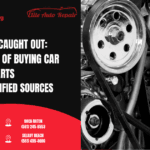Imagine your car is like a race car, even if it’s just your daily driver. Brake pads and rotors are the unsung heroes of your vehicle’s performance, and the better they work, the better you drive. Here’s a more exciting way to look at it:
Brake Pads: The “Toughest” Road Warriors
Think of brake pads like the gloves of a boxer, made to take the hits and protect the important parts (in this case, your rotors). They are the ones actually doing the “dirty work” when you hit the brake pedal. The pads clamp down on the rotors, creating the friction that stops your wheels from spinning.
Materials Matter
Different materials give different vibes. You could say they’re like the different fighting styles of a boxer:
- Organic Pads: The gentle fighters, offering smooth stops with less noise but they wear out faster—perfect for those who cruise around town and want quiet brakes.
- Semi-Metallic Pads: These are the heavy hitters—more aggressive and responsive, but a little louder. If you drive a lot in traffic or in hot climates, these pads bring heat resistance and long-lasting power.
- Ceramic Pads: Think of them like the high-tech, almost too quiet fighters. They’re expensive but durable and give you the best braking performance with less dust—just like a pro athlete who never breaks a sweat.
Over time, the pads will get thin. And when they do, they start to lose their grip on the rotor, just like a boxer whose gloves start to lose their padding. You’ll know it’s time when you hear that dreaded squeak or feel your brakes start to lose power.
Rotors: The “Underdog” Who Takes the Hits
Now, the rotors are the unsung champions. They don’t get as much love, but they’re the ones absorbing all the punishment when the pads do their thing. When you brake, the pads clamp down on the rotors and slow everything down through friction. The rotors are the surface that gets scarred, burned, or sometimes even cracked. But if they get too damaged, you can kiss smooth braking goodbye.
Types of Rotors: The Cool Kids’ Club
- Solid Rotors: Classic and reliable—your everyday, all-around performer. No frills, just work.
- Ventilated Rotors: The turbo-charged versions. These guys have channels to help keep them cool during high-speed braking. Think of them like cooling systems for your engine—except for your brakes.
- Drilled Rotors: These are the show-offs. They look like they belong in a race car, with holes drilled all over them to help keep your brakes cooler and perform better. But they can be fragile—too much heat or stress and they could crack.
- Slotted Rotors: These are the best of both worlds. Grooves help move gases, dirt, and water off the rotor, preventing slippage and maintaining better performance. Think of them as the rotor that can do it all—look tough and stay reliable under pressure.
The Big Danger: Warped Rotors
When rotors get warped (which is often caused by overheating), they no longer have a flat surface. That’s when you start feeling your brake pedal pulsate. It’s like trying to slow down a car while driving over a bumpy road. Not ideal, right?
How Brake Pads and Rotors Work Together: The Dynamic Duo
Picture this: You’re cruising down the road, and you need to stop at a red light. When you press the brake pedal, hydraulic force pushes the brake calipers, which grip the brake pads. These pads squeeze down on the rotors, turning the car’s rotational energy into heat through friction. That’s what actually slows the wheels down. It’s a dance of science and engineering. A perfectly synchronized waltz where every part is essential.
How They Work Together
- When you press the brake pedal, hydraulic fluid pushes the brake calipers, which squeeze the brake pads onto the rotors.
- The friction between the pads and rotors slows the rotation of the wheels, reducing the vehicle’s speed.
- As the brake pads wear down, they become thinner, which can lead to decreased braking performance. Rotors can also become warped or damaged over time.
Signs You Need to Replace Them
- Brake Pads:
- Squeaking or squealing sounds (often due to wear indicators built into the pads).
- Longer stopping distances or reduced braking performance.
- A metallic grinding noise (when the pads are worn down completely and metal is rubbing against metal).
- Brake Rotors:
- Vibration or pulsation felt through the brake pedal when applying the brakes.
- Visible grooves, cracks, or scoring on the rotor surface.
- Excessive heat buildup or fading brakes.
Replacement Considerations
- When replacing brake pads, it’s often recommended to replace the rotors at the same time, especially if the rotors are worn or damaged.
- Ensure that both components match the specifications of your vehicle for proper performance and safety.
- After replacement, it’s important to “bed” the brake pads—this involves a series of braking maneuvers that help the pads settle in and form an even layer of friction material on the rotor surface.




